Introduction


The area where we live has an interesting history which is worth telling. For thousands of years the area was a favorite meeting place for that Aboriginal tribes in the area, the Turrbal people. They had access to fresh water, and they used the land all the way from what is now Spring Hill to the river, where they had access to plenty of fish. The springs also created a swampy area next to the river that again was a source of various foods.
The area was heavily used by the Aboriginal people – perhaps one of the densest populated areas in Australia at that time. It stretched all the way from where is now the Exhibition Centre and Victoria Park (than known as York Hollow – York was the nickname given to the Aboriginal leader). That area extended to where now Suncorp Stadium and the Barracks are situated, at that stage known as Green Hills. And than of course the area what is now Roma Street Parkland. These lands were also used for inter tribal activities such as corroborees and tournaments (Pullen Pullen). Tribes that came to this area included those from Ipswich, Tweed Valley, Wivenhoe, Rosewood, Logan, Stradbroke, North Pine and beyond (Aboriginal Camp sites of Greater Brisbane – Dr Ray Kerkhove). These activities often lasted for month and all these people had to eat, this gives an indication of how rich the area and its surroundings was in food sources.
See also:
Moreton Bay Penal Colony and early settlement
The founder of the penal colony what is now Brisbane, Henry Miller noticed the creek and the ponds and saw its potential for the building of the convict colony. I have written the history of the Convict Settlement here.
The windmill was a major convict building in the area under discussion and will be covered in the information bellow.
Once the European population grew, people started to build houses along George Street, Roma Street and Wickham Terrace.
The names Roma Street Parkland, Roma Street, Countess Street, Roma Street Station all refer to Contessa Diamantina di Roma the wife of the first Governor of Queensland George Bowen.
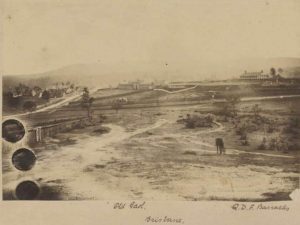
When the railway arrived, the area was chosen for the main station of the city for the line to Ipswich. The railway in these early days was built for the transport of goods. Passenger trains did not start to arrive until early in the 20th century. The railway totally changed the nature of the area, and it became an industrial area.
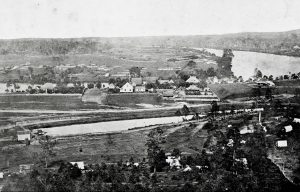
When Queensland Rail decided to move its railway yard to Bowen Hills, Premier Bjelke Petersen wanted to use the site for a casino. Fortunately, he lost the elections and thanks to the next premier we now have this beautiful Roma Street Parklands.
So, the boundaries of the area that I will discuss in this article are basically Wickham Terrace in the north, the river in the south, Countess Street and the Victoria Barracks towards the west and the CBD proper to the east.
The Railways
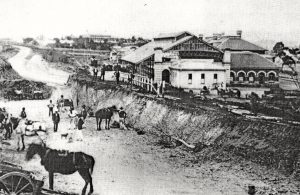
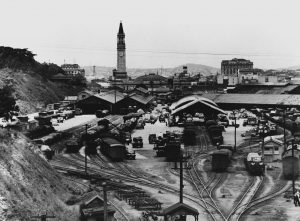
In 1864 at Ipswich Contessa Diamantina turned the first sod for Queensland’s first railway-line between Ipswich and Bigge’s Camp (later Grandchester) using a silver spade and a cedar wheelbarrow. This line was completed in 1872. It was extended to Oxley West (Sherwood) in 1874 and to Brisbane in 1876 where it ended at Roma Street.
The main purpose of the railway was for the transport of goods (wool, wheat, coal, minerals, fresh produce, dairy products, and other farm products). However, lack of funds saw the rail line ending at the outskirts of the town. This was a far from ideal spot as it was away from the city and not next to the river.
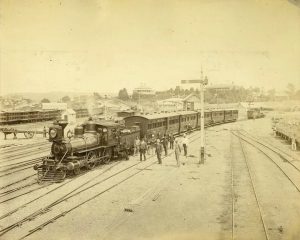
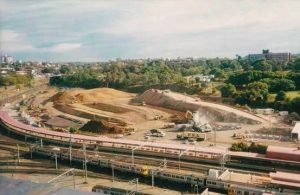
Before the railway arrived the major transport line between Brisbane and Ipswich was the Brisbane River. As a region this was the most developed part of the fledging colony. As a matter of fact, Ipswich was considered to become the capital of the new state and it only just missed out to Brisbane.
The Roma Railway station (known as Brisbane Terminal) was completed in 1875, the goods shed a year later, and the engine shed for the steam locomotives as well as the carriage sheds followed in 1877. Originally built as single track, the section was duplicated from 1885–87, indicating how quickly the traffic volume grew on the line. The Albert Bridge was built to accommodate two tracks in 1876, though only one was laid at the time. While there was some passenger travel in the early years, passengers transport only started to become more prominent in the 1930s and 1940s.
The extension to what is now Central Station was completed in 1887 and the station on Ann Street was opened in 1901. At that time, it became the major passenger’s station, and the Brisbane Terminal name was changed to Roma Street Station and hosted the main railyards of the city.
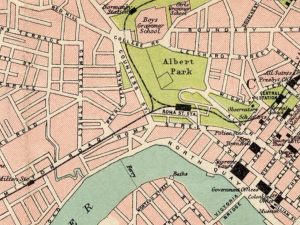
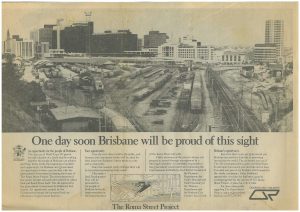 The railways kept growing and a large section was added to the yards in 1911. For that purpose, a large section of what was Albert Park had to be excavated and the rock wall in Roma Street Parklands shows the extend of the yards. The excavation delayed the project and was not finished until 1920. This now allowed for the building of five large new sheds, the last one completed in 1933. Albert Park was established in 1866, a few years after Prince Albert Consort had died. The remnants of this park – being the top end – have been incorporated in the Roma Street Parklands.
The railways kept growing and a large section was added to the yards in 1911. For that purpose, a large section of what was Albert Park had to be excavated and the rock wall in Roma Street Parklands shows the extend of the yards. The excavation delayed the project and was not finished until 1920. This now allowed for the building of five large new sheds, the last one completed in 1933. Albert Park was established in 1866, a few years after Prince Albert Consort had died. The remnants of this park – being the top end – have been incorporated in the Roma Street Parklands.
The ongoing growth of the railway system resulted in the site again be not big enough. By the mid-1960s the plan was to move the yards to the outskirts of the city. However, they decided to build extra lines on an ever-congested area, as there was not enough room this became a sharp bend which became the squealing bends leading to that marshalling yards at Normanby. By 1881 the State Government had to bite the bullet and the State Railway Department after again considering a Roma Street upgrade finally decided to move the yards to Acacia Ridge. The goods yard was finally closed in 1991. Most of the sheds were demolished but a small part was used for passengers’ platforms.
Historical overview. Roma Street Parklands precinct Brochure by Thom Blake, 2002.
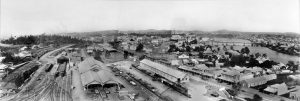
Countess Street Powerhouse

The Brisbane tramway network served the city of Brisbane, Australia, between 1885 and 1969. It ran on standard gauge track. The first electric tramway ran along Stanley Street, in South Brisbane on 16 June 1897.Horse-drawn carriages were still being used in 1899.
Workshops and administration for the electric tram system opened in 1897 and were initially located in cramped quarters at Countess Street, at the western side of the Roma Street railway yards (now the site of the Roma Street Parklands), but in 1927 were relocated to Milton. This happened after Brisbane’s tramway system came under the control of the newly merged Brisbane City Council in 1925.
The electric system was originally energised to 500 volts, and subsequently increased to 600 volts. Power for the electric trams was originally drawn from a power station operated by the tramway company adjacent to its Countess Street depot and workshops. As the tramway company increased both the number of trams and the length of routes, the power supply rapidly became inadequate. Power stations were added in Fortitude Valley and Wooloongabba. A totally new power station was build in New Farm in 1928, now used as a theater complex (The Powerhouse).
Roma Street Markets
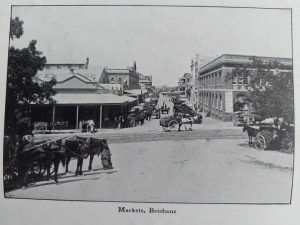
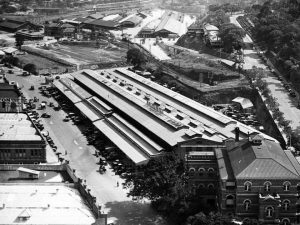 The first municipal market hall in Market Street, in the city, was established in 1867. By 1881 this had become to small. A new site was selected close to Roma Street Station towards the city and towards George Street. For a while it also hosted the cattle sale yard (also moved from Market Street) , however it failed to become a financial success and was moved to New Market.
The first municipal market hall in Market Street, in the city, was established in 1867. By 1881 this had become to small. A new site was selected close to Roma Street Station towards the city and towards George Street. For a while it also hosted the cattle sale yard (also moved from Market Street) , however it failed to become a financial success and was moved to New Market.
There are still several building around the Roma, Turbot and George Street that are reminders of the once busy Roma Street Markets. In 1964 these markets moved again this time to Rocklea where they still operate.
Brisbane Boys Grammar School
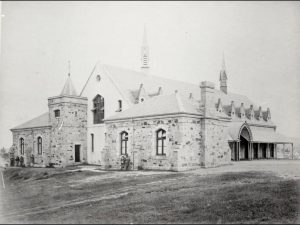
By far the most pleasing building in the area was the Brisbane Boys Grammar School, opened in 1869. However, when the railway arrived, the school stood in the way and was aquarel by the State Government. Just over a decade after it was build the students and staff moved to a new school build only a few hundred meters further at its current site on the corner of Countess Street and Gregory Terrace. The old building survived as the Transport Building for the railways offices but was finally demolished in the early 1900s when track expansion was needed for the ever-increasing railway yard. The Brisbane Girls Grammar School was opened in 1884 next the boys school.
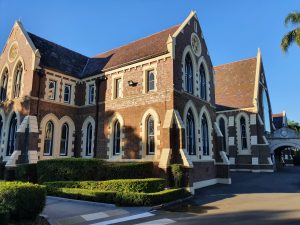
On 1879, Portion 322 of the Kelvin Grove development was granted by the colonial government to the Brisbane Grammar School as an endowment. The school retained the endowment until 1911, leasing grazing rights to the holding as a means of raising funds for the school. No buildings were thought to have been constructed on the site throughout this period.
In May 1911, the Commonwealth Government acquired the endowment, and renamed the site the Kelvin Grove Defense Reserve. Soon the military erected here the Gona Barracks, for the purpose of military training for specialist units of compulsory militia forces. The site continued to develop and became a Citizens Military Force training complex in the 1950s, and later an Army Reserve recruitment centre. Gona is a beach in PNG where the Australians landed and started the Kokoda campaign.
Cricket Ground
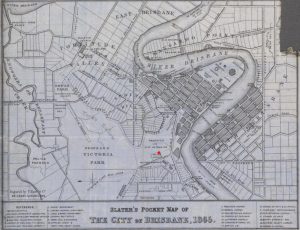
The first cricket match played at the Green Hills Sports Ground (located where the Parkland Boulevard buildings 6 and 7 now are) commenced on 6 May 1860 between Married and Single Members of the Moreton Bay Cricket Club. A report stated that “the Benedicts cut rather a queer figure, averaging per man only a fraction of a run. Their score amounted to 10. Seven of their opponents were dismissed for 61 runs, Messrs. Birley and Coles scoring 22 and 18 respectively.”
In December 1861, it was resolved to invite a team from England to play here, but “the desired visit of the Englishman did not eventuate.”
Another Married vs Single match took place in February 1862. The report of this match concluded “the bowling, batting and fielding throughout the game plainly showed the amount of practice that is needed before we can hope to make up a team of cricketers that would make even a decent show in comparisons with the ‘crack elevens of the other colonies.” The dinner after the match was at least more successful: “the company broke up at a quarter to twelve after having spent a most pleasant evening, the harmony of which was not marred by any unpleasant occurrence.”
A “grand match” between 22 players from Queensland and 11 from New South Wales commenced on a wet, wintry, Green Hills day on 3 June, 1864. The Brisbane Courier reported:
“Portions of the field there were 2 or 3 inches of water; but seeing very few hits were made very far away from the wicket, no very inconsiderable inconvenience was caused thereby” “The players and their friends partook of an excellent lunch provided by Messrs. Stewart and Shaw, towards the conclusion of which, His Excellency the Governor and Lady Bowen arrived. The whole of the cricketers turned out and greeted the vice-regal party with three hearty cheers” “those individuals who preferred outside the fence and a bad view of the ground to the payment of one shilling for entrance, their conduct savours somewhat of meanness.” “With regards to the play, we can only say it was admirable on both sides; and although some astonishment was created at the New South Welshmen being all out for 32 runs, when it is remembered that the ground is so very much inferior to that of a well-grassed Domain, that the twenty-two, with one or two exceptions, fielded with perfection; and that the bowling was anything but indifferent, we certainly cannot see that there is much cause for surprise”
The final scores were:
- New South Wales fist innings: 32; (Foden 6 wickets, Shaw 4 wickets)
- Queensland first innings: 45 (Lawrence 14 wickets, Thompson 7 wickets)
- New South Wales second innings: 145 (Clarke 42 runs, Deedes 3 wickets)
- Queensland second innings: 49 (Bolger 26 runs, Moore 11 wickets)
Alas, this was to be the first and last inter-colonial game to be played at Green Hills.
Sources:
- Hutcheon, E.H. A History of Queensland Cricket, 1934.
- The Cricketers’s Arms, Cricket Street, 1880s. (from Steve Woolcock)
Wickham Terrace
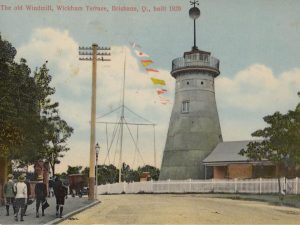

The tread mill and the wind mill
In 1827 a treadmill and windmill were built on the hill just above the settlement (now Wickham Terrace). A track from the back of the Convict Barracks was constructed in order to bring up the building supplies. A small log bridge was built over the creek roughly where Albert Street and Adelaide Street meet.
While they were both constructed to grind the maize that was cultivated by the convicts for the Moreton Bay penal settlement, Captain Logan saw the treadmill also as an excellent opportunity for punishment. It was euphemistically called by the convicts, the ‘dancing academy’. The mechanism was operated by 16 convicts with 8 persons waiting. They shuffled along the board every five minutes and had rest of approx 15 minutes at the end of each cycle. In normal conditions they would effectively be on the treadmill for about 5 hours and 20 minutes over a 10 to 11 hour day, which include a 2 or 3 hour lunch break. However punishments could see them working on the mill for 14 hours, most with their leg irons on, sometimes with fewer people and therefore with fewer breaks. This was well above daily maximum set by the British Society for the Improvement of Prison Discipline. No wonder that several convicts died while working the treadmill. Read the full story here.
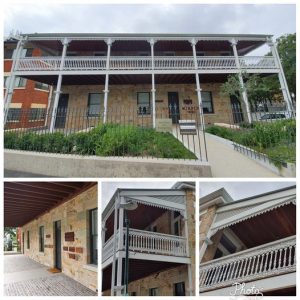 Athol Place
Athol Place
Athol Place is a row of three Colonial Georgian style terrace houses at 307 Wickham Terrace built in the 1860s by Alexander McNab, named after his hometown of Blair Atholl in Scotland. He used it rent out rooms. It was used by physicians, lawyers and functioned as a boarding house for Brisbane Girls High School. Recently lovely restored and part of a new eight story commercial building behind Athol Place to be used for offices and health care services (principally medical consulting rooms) as well as a rooftop food and drink outlet. It was the house of Brisbane first medical doctor Joseph Bancroft. He arrived in Brisbane on 29 October 1864, having travelled on the Lady Young as a surgeon. After a short holiday he began to practise in Spring Hill one of the first residential quarters of Brisbane, and certainly the most prestigious one.
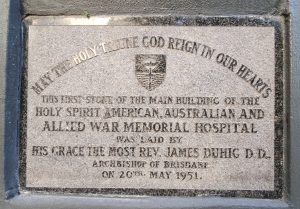
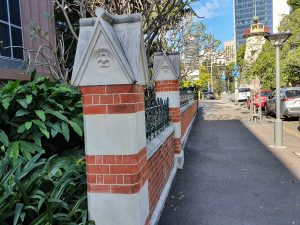
Garth House – Holy Spirit Hospital – Brisbane Private
On March 27th 1945, six surviving sisters who had been rescued by the Australian Defence Force in PNG where provided with Garth House at Wickham Terrace where they established theur Holy Spirit Convent. In 1947, the Archdiocese of Brisbane formally transferred ‘Garth House’ to the Sisters. They expanded this with a hospital. In 1950, the by now 100 bed hospital was dedicated by the sisters to the troops who had rescued them. They called it the Holy Spirit American, Australian and Allied War Memorial Hospital. In 2003, the Sisters sold the Hospital at Wickham Terrace to Queensland Private Hospitals Ltd. It is currently known as Brisbane Private Hospital and in 2007 was acquired by Healthscope. Read the full story here.

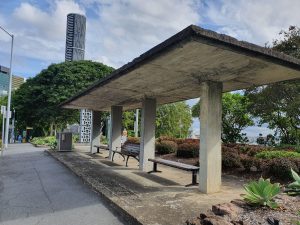 Bomb Shelter entrance Roma Street Parklands
Bomb Shelter entrance Roma Street Parklands
There were 230 air raid shelters built in Brisbane around 1941 and 1942, there is another one further along Wickham Terrace. They were built just prior to the arrival of US General MacArthur when the city became one of the four big centres in the Pacific Region for Allied forces defending freedom. The main staging camp for the South West Pacific Campaign was Camp Columbia.
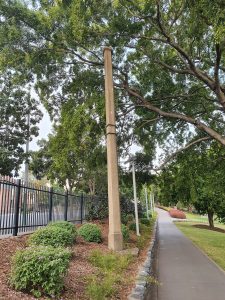
Monier Ventilation Shaft 1, 1904
Just inside the Roma Street Parklands opposite the Grand Chancellor Hotel. They were built to ventilating storm-water and sewers.
There is another one just outside Parklands and one (a steel one) closer to the Windmill, both along Wickham Terrace.
Paul Budde – updated June 2023